
Valley of the Kings
![]()
| Across the Nile from the great temple complexes of Luxor and Karnak is a vast 'City of the Dead'. In deep valleys on the western
side of the river, the bodies of pharaohs, queens and nobles of the second millennium BCE
were buried with all the ritual necessary to ensure their survival in the afterlife. The
famous Valley of the Kings is only one
part of this whole great necropolis. The valley is a remote, desolate place
with no vegetation. Rising above the area is the Qurn ("horn"), a mountain which
many regard as a natural pyramid shape
which presides over the entire cemetery. Over 60 pharaohs' tombs have been discovered, but only a small
number can be visited. Tutankhanum's tomb in the Valley of the Kings may be visited but not photographed. Visit King Tut's Tomb and Museum, at the Luxor Hotel and Casino in Las Vegas, to see the only full-scale authentic reproduction of the pharaoh's tomb outside Egypt. |
![]()
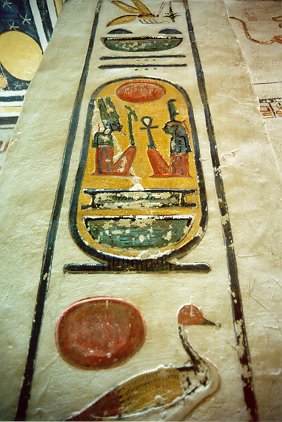 Royal Cartouche of a pharaoh buried in his Valley
of the Kings Tomb. The hieroglyphs
at the very top of the column (a bee and sedge) denote that he is King of Upper and
Lower Egypt. The sun and goose at the bottom denote that he is Son of Re.
Royal Cartouche of a pharaoh buried in his Valley
of the Kings Tomb. The hieroglyphs
at the very top of the column (a bee and sedge) denote that he is King of Upper and
Lower Egypt. The sun and goose at the bottom denote that he is Son of Re.
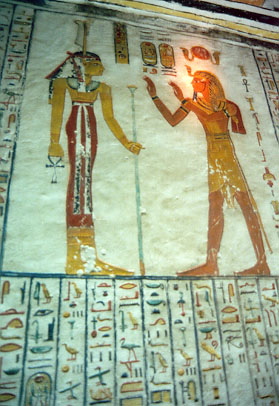 Ramesses raises his
hands in homage to the goddess, Ma'at.
Ramesses raises his
hands in homage to the goddess, Ma'at.
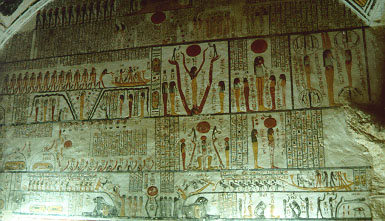 The burial
chamber of the tomb of Ramesses VI is decorated with texts and illustrations related to
the Book of Earth dealing with the theme of the creation of the solar disk. The
Book of Earth is one of the great anthologies of magic-religious texts which describe the
journey of the sun-god Re in the Underworld and his going out into the light.
The burial
chamber of the tomb of Ramesses VI is decorated with texts and illustrations related to
the Book of Earth dealing with the theme of the creation of the solar disk. The
Book of Earth is one of the great anthologies of magic-religious texts which describe the
journey of the sun-god Re in the Underworld and his going out into the light.
 The astronomical ceiling
of Ramesses VI's burial chamber is decorated with scenes illustrating the Book of the
Day and the Book of the Night. A double representation of the goddess Nut,
personification of the celestial vault and the "Mother of the Sun", is
represented in the act of swallowing up the sun in the evening and regenerating it in the
morning. She thus assumes the role of a life-giving and regenerating force that shines
down upon the dead pharaoh, assimilated with Re with whom he shares the rebirth. Portions
of the Book of the Dead are also located
in the pillared chamber.
The astronomical ceiling
of Ramesses VI's burial chamber is decorated with scenes illustrating the Book of the
Day and the Book of the Night. A double representation of the goddess Nut,
personification of the celestial vault and the "Mother of the Sun", is
represented in the act of swallowing up the sun in the evening and regenerating it in the
morning. She thus assumes the role of a life-giving and regenerating force that shines
down upon the dead pharaoh, assimilated with Re with whom he shares the rebirth. Portions
of the Book of the Dead are also located
in the pillared chamber.
The sky goddess Nut
is seen swallowing the sun each evening and giving birth to it each morning. The scene is
shown on the ceiling of a tomb in the Valley of the Kings.
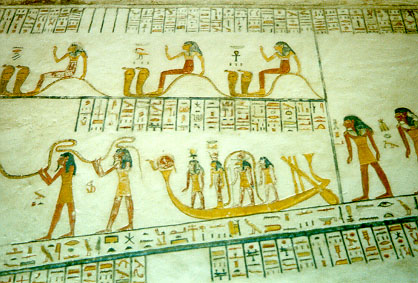 I'm not sure what this means, nor, unfortunately,
am I even sure whose tomb it was taken in, but the people
"riding" the cobras looked too interesting not to post it.
If you know what this is, please let
me know.
I'm not sure what this means, nor, unfortunately,
am I even sure whose tomb it was taken in, but the people
"riding" the cobras looked too interesting not to post it.
If you know what this is, please let
me know.
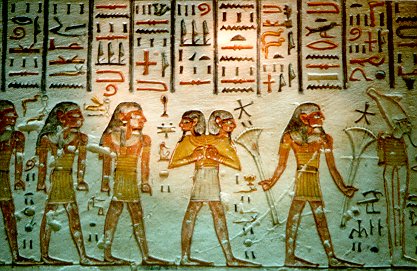 Wall panel depicting Aker, an earth-god who watched over the western and eastern gates of the
duat (underworld). He is depicted either with a lion's head or with two human heads facing
in opposite directions as he is shown here. My thanks go out to Marj Morriss who was able to identify him for me.
J
Wall panel depicting Aker, an earth-god who watched over the western and eastern gates of the
duat (underworld). He is depicted either with a lion's head or with two human heads facing
in opposite directions as he is shown here. My thanks go out to Marj Morriss who was able to identify him for me.
J
© All pictures are Copyright 1998 - 2000 Grisel Gonzalez